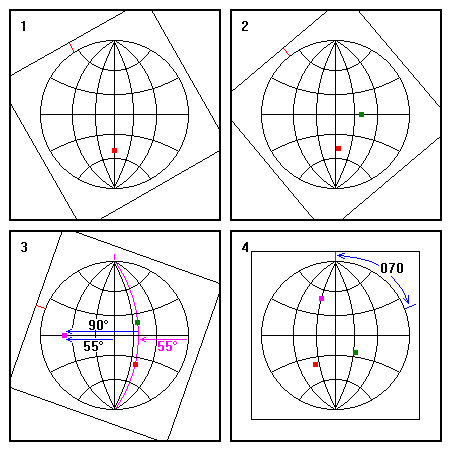Use a Stereonet to Find the Pole to a Plane Given Two Apparent Dips
Steven Dutch, Professor Emeritus, Natural and Applied Sciences, University of Wisconsin - Green Bay
Example
On two joint faces we observe the apparent dip of banding in gneiss. On one joint striking 034, the apparent dip of the banding is 40 degrees to the southwest, and on the other joint, striking 128, the apparent dip is 50 degrees southeast.
We have to solve this problem because we can't get at the banding to measure strike and dip directly. All we have is the banding on two joint faces - in other words, lines. This problem is simply a matter of finding the plane containing two lines.
Apparent dip is just the dip as seen in a plane oblique to the strike. The strike of the section plane will give us the trend of the line, the apparent dip is just the plunge.
For the first plane, the trend could either be 034 or 214. Since the banding has an apparent dip to the southwest, the trend is 214. The plunge is 40 degrees.
For the second plane, the trend could either be 128 or 308. Since the banding has an apparent dip to the southeast, the trend is 128. The plunge is 50 degrees.
The problem boils down to finding the plane that contains two lines, one trending 214, plunging 40, and the other trending 128, plunging 50.
 |
1. Plot the first line. Rotate the overlay so that trend 214 lies on a vertical great circle. Count in 40 degrees from the primitive circle and plot the line (red). 2. Rotate the overlay so that trend 128 lies on a vertical great circle. Count in 50 degrees from the primitive circle and plot the line (green). 3. Rotate the overlay so the two points lie on a common great circle (purple). Count the dip in from the primitive circle. Locate the pole by either counting 90 degrees from the great circle or by counting the dip starting at the center of the net. Also, draw a tick mark to indicate the strike. 4. Rotate the overlay to its original position and measure the strike. |
Return to Course Syllabus
Return to Techniques Manual Index
Return to Professor Dutch's Home Page
Created 13 September 2000, Last Update